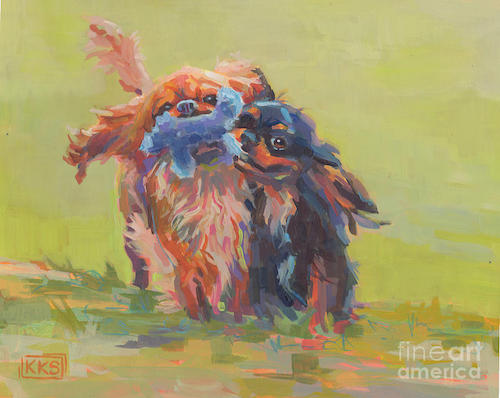
Critics charge that the world of show dogs can be political, but history has proved that a breed itself can be, and one need not look further than the King Charles Spaniel.
“Charlies” were thought to have been brought to Scotland from France in the 1500s by Mary, Queen of Scots, though at the time, they were called Toy Spaniels. In the years between Mary’s death and Charles I’s ascension to the throne, the dogs had become popular, no less so with Charles I whose dog, “Rogue” was by his side when he was held captive on the Isle of Wight in Carisbrooke Castle. It was under the House of Stuart and Charles II (aka the “Cavalier King”) that the breed came to be known as the Cavalier King Charles.
Charles II had been in exile in the Netherlands, and he was rarely without his dogs. Indeed, on the day he returned to England from exile, Samuel Pepys, Charles’ future Chief Secretary to the Admiralty and an avid diarist, wrote in his diary: “The King was rowed ashore in the Admiral’s barge, while I followed in a smaller boat with Mr. Mansell, one of the footman and a dog that the King loved.” This affection for a dog, however, was not a quality that Pepys admired. He later wrote that Charles was always in trouble for “playing with his dogs all the while, and not minding his business,” but the people adored their king, a notorious party animal nicknamed the Merry Monarch for that reason.
Charles died of kidney failure in 1685 and left behind over a dozen of his beloved dogs, most said to be in his room at the time of his passing. His brother, James II (and another dog lover) succeeded Charles, but they had made a pact to carry on breeding the dogs in the event of Charles’ death. It was James who, when forced to abandon ship off the Scottish coast, gave the order to “save the dogs!” and as an afterthought, added, “and Colonel Churchill.” Not to get too far off the rails, but Churchill also kept small red and white spaniels, and it was Churchill’s wife, Sarah, who repeatedly pressed her thumb into the forehead of her pregnant bitch while her husband was fighting in the Battle of Blenheim. When five puppies were born with red “thumbprint” marks on their foreheads, the marks became known as the Blenheim spot.
But we digress.
The King Charles Spaniel maintained its “royal status” until James was deposed in the Glorious Revolution. He was replaced by William III and Mary II which bode poorly for the breed because Queen Mary preferred Pugs. Indeed, not only did the King Charles Spaniel quickly become canine non grata, but ownership of one was seen as treasonous. Some believe it also lead to drastic physical changes to the breed, and at least one source writes that Pugs may have been bred then with the King Charles Spaniel leading to the flat face of the modern Cavalier King Charles Spaniel.
As they say, what goes around, comes around. In time, the Pug, too, would have its moment as a notorious secret symbol.
Even history cannot separate a monarch from his dogs. In 1881, Hugh Dalziel wrote in his book British Dogs: “The merry monarch did many more foolish things than take under his royal care and favor, and thereby raising to court, the beautiful toy spaniel which still bears his name.”
Image: “Besties” by Kimberly Santini
www.paintingadogaday.com
www.facebook.com/KimberlyKellySantini
http://paintingadogaday.blogspot.com
Toy breed owners, each of our breeds has a history. Help preserve your breed by educating the public with the “Ask About My Heritage” bandana.

Hello!!!!! The correct name of this beautiful purebred breed of dog is: CAVALIER King Charles Spaniel. Or “Cavalier” if you really must shorten it. This story is about The Treasonous Cavalier Owner!!!! Not “Cav” and definitely not “Cavie” which is a guinea pig! And, South American cavies are not especially cute at all!!! Cavalier breeders and owners have enough trouble helping pet-parents learn the correct name of our breed of gorgeous spaniels…. we certainly don’t need NPBD to sanction the incorrect nick-name. Love the painting, though — the artist does lovely dog paintings.
Thanks for the input, Lynn. Our post titles are often dictated by space limitations, as was the case with this one. Your objection and correction is duly noted and we hope everyone makes note of the proper name for a wonderful breed.